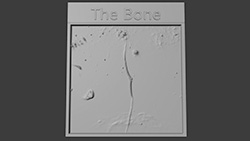CXC Home | Search | Help | Image Use Policy | Latest Images | Privacy | Accessibility | Glossary | Q&A
1
X-ray and Radio Images of G359.13142-0.20005, The BoneCredit: X-ray: NASA/CXC/Northwestern Univ./F. Yusef-Zadeh et al; Radio: NRF/SARAO/MeerKat; Image Processing: NASA/CXC/SAO/N. Wolk
These images show a structure that resembles a fractured bone called G359.13142-
0.20005 (G359.13 for short) near the center of our Galaxy. X-ray data from Chandra and MeerKAT radio data reveal that this ‘bone’ has been struck by a fast-moving, rapidly spinning neutron star, or pulsar. Neutron stars are the densest known stars and form from the collapse and explosion of massive stars. They often receive a powerful kick from these explosions, sending them away from the explosion’s location. Astronomers estimate the pulsar that caused this fracture was traveling between one and two million miles per hour.
2
3D Printable Files: G359.13142-0.20005, The Bone(3D Print Credit: NASA/CXC/A. Jubett, using software by Tactile Universe/N. Bonne & C. Krawczyk & Blender)
This tactile plate is a physical relief map based on the intensity of Chandra X-ray data along with radio data from MeerKAT, featuring a long, thin, cosmic structure. With the structure’s vertical orientation, seemingly fragile thin dimensions, and raised ridge against the vast empty immediate area of space, the plate resembles a medical X-ray of a long, thin, bone. The structure, called G359.13, or “The Snake”, is a Galactic Center Filament. These filament formations are threaded by parallel magnetic fields, and spiraling, energized particles. The particles cause radio waves, which can be detected by radio arrays, in this case by the MeerKAT array in South Africa.
The largely straight filament stretches from the top to the bottom of the plate. At each end of the filament is a hazy cloud. The plate is sparsely dotted with a few specks surrounding the structure. These specks represent X-rays detected by NASA’s Chandra X-ray Observatory.
One such speck appears to be interacting with the structure itself. This is a fast-moving, rapidly spinning neutron star, otherwise known as a pulsar. Astronomers believe that this pulsar has struck the filament halfway down its length, distorting the magnetic field and radio signal. This distortion resembles a small break, or spur, in the bone-like filament.
The largely straight filament stretches from the top to the bottom of the plate. At each end of the filament is a hazy cloud. The plate is sparsely dotted with a few specks surrounding the structure. These specks represent X-rays detected by NASA’s Chandra X-ray Observatory.
One such speck appears to be interacting with the structure itself. This is a fast-moving, rapidly spinning neutron star, otherwise known as a pulsar. Astronomers believe that this pulsar has struck the filament halfway down its length, distorting the magnetic field and radio signal. This distortion resembles a small break, or spur, in the bone-like filament.
Return to: NASA's Chandra Diagnoses Cause of Fracture in Galactic "Bone" (May 1, 2025)









